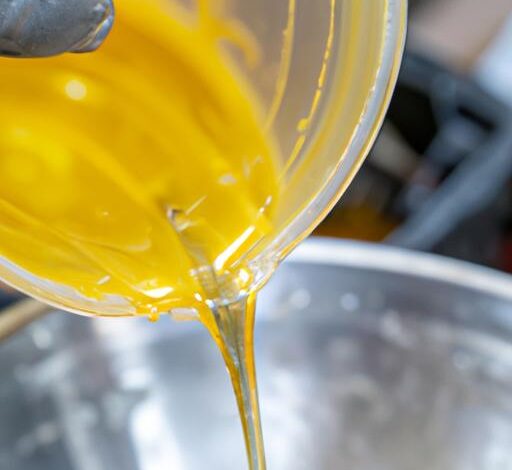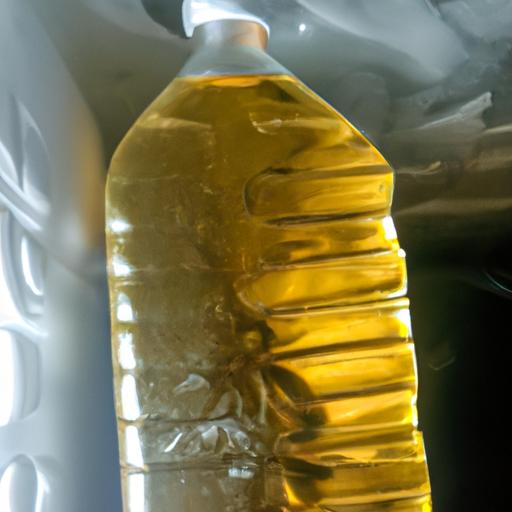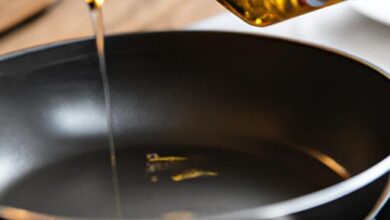Can Cooking Oil be Reused? A Comprehensive Guide

Introduction
Cooking oil plays a vital role in our everyday lives. From frying to sautéing, it adds flavor and texture to our favorite dishes. But have you ever wondered what happens to that oil once we’re done cooking? The environmental impact of disposing of used cooking oil is a growing concern. However, there is a better solution – reusing cooking oil. In this article, we’ll explore the possibilities and answer the burning question: can cooking oil be reused?
Importance of cooking oil in everyday life
Cooking oil is an essential ingredient found in countless recipes worldwide. It not only acts as a medium to cook our favorite meals but also enhances the taste and aroma. Just imagine biting into a crispy golden fried chicken wing or indulging in a perfectly seared steak – cooking oil is the secret behind these culinary delights.
Concerns about the environmental impact of disposing of used cooking oil
While cooking oil brings joy to our taste buds, its disposal poses significant environmental challenges. Improper disposal of used cooking oil can contribute to clogged pipes, sewage system issues, and even environmental pollution. It’s crucial to find sustainable ways to handle this waste product, considering its widespread use in households and restaurants alike.
Now that we’ve established the significance of cooking oil in our lives and the concerns surrounding its disposal, let’s delve into the intriguing possibility of reusing cooking oil. Is it truly feasible? Stay with me to find out!
Understanding Cooking Oil
A. Types of cooking oil commonly used
When it comes to cooking oil, we are spoilt for choice. Different types of cooking oils offer unique flavors, smoking points, and nutritional profiles. Some commonly used cooking oils include:
-
Vegetable Oil: This versatile oil is extracted from various plant sources, such as soybeans, corn, or canola. It has a neutral taste and a high smoking point, making it suitable for frying and baking.
-
Olive Oil: Known for its rich flavor and health benefits, olive oil is derived from olives. It comes in different varieties like extra virgin, virgin, and regular. Extra virgin olive oil is ideal for dressings and low-heat cooking, while regular olive oil is suitable for sautéing and roasting.
-
Coconut Oil: Extracted from the meat of coconuts, coconut oil adds a unique tropical taste to dishes. It has a high smoking point and is commonly used in baking, stir-frying, and as a dairy-free substitute in recipes.
-
Avocado Oil: This oil is pressed from the pulp of avocados and has a mild, buttery flavor. With a high smoking point, avocado oil is excellent for grilling, sautéing, and salad dressings.
B. Properties and characteristics of cooking oil
Each type of cooking oil has its own set of properties and characteristics that make it suitable for different cooking methods. Factors such as smoking point, flavor, and nutritional content vary among oils. For instance:
-
Smoking Point: This is the temperature at which the oil starts to break down and produce smoke. Oils with higher smoking points are better for high-heat cooking methods like deep-frying, while oils with lower smoking points are ideal for delicate cooking techniques.
-
Flavor: Cooking oils range from neutral to robust flavors. Some oils, like sesame oil, have a distinct taste that can add depth to Asian-inspired dishes, while others, like grapeseed oil, have a milder flavor that won’t overpower the other ingredients.
-
Nutritional Content: Different oils offer various health benefits. For example, olive oil is rich in monounsaturated fats and antioxidants, while sunflower oil is high in vitamin E. Understanding the nutritional content of cooking oils can help you make healthier choices in the kitchen.
C. Factors affecting the quality of cooking oil
The quality of cooking oil is influenced by several factors. These factors include:
-
Storage: Exposure to light, heat, and air can cause cooking oil to deteriorate and become rancid. Proper storage in a cool, dark place is essential to maintain its quality and extend its shelf life.
-
Reuse: Reusing cooking oil multiple times can impact its quality. Each time the oil is used, it can break down, absorb flavors, and accumulate impurities. It’s important to consider the number of times oil has been reused before deciding whether it’s suitable for further use.
-
Filtration: Filtering used cooking oil helps remove food particles and impurities, which can affect the quality of the oil. Proper filtration can help prolong the usability of cooking oil.
Understanding the different types of cooking oil, their properties, and the factors that influence their quality is vital to make informed decisions about reusing cooking oil. In the next section, we’ll explore the benefits and considerations of reusing cooking oil.
Can Cooking Oil be Reused?
Benefits of reusing cooking oil
You may be surprised to learn that reusing cooking oil comes with several benefits. Not only does it save you money by reducing the frequency of oil purchases, but it also promotes sustainability by minimizing waste. By reusing cooking oil, you can enjoy the same delicious flavors and textures in your dishes while being mindful of the environment.
Factors to consider before reusing cooking oil
Before jumping into the practice of reusing cooking oil, there are a few crucial factors to consider. First and foremost, you need to assess the quality of the oil. Is it still clear and free from any visible impurities? Additionally, the type of food cooked in the oil plays a role. Highly flavored or heavily seasoned foods may leave behind unwanted flavors that can affect subsequent dishes. Straining the oil through a fine-mesh sieve can help remove any food particles and extend its usability.
Another vital aspect to consider is the smoking point of the oil. Each type of cooking oil has a specific smoking point, which is the temperature at which it starts to break down and produce smoke. Reusing oil beyond its smoking point can lead to the formation of harmful compounds that may pose health risks. It’s essential to know the smoking point of the oil you’re using and avoid exceeding it during subsequent uses.
Methods to properly store and reuse cooking oil
To ensure the safe reuse of cooking oil, proper storage is key. Once the oil has cooled down, strain it to remove any food particles and debris. Transfer the oil to an airtight container, preferably one that is opaque to prevent exposure to light, which can deteriorate the oil’s quality. Store the container in a cool, dark place away from direct sunlight and heat sources. Remember to label the container with the date of initial use to help track its usability.
When reusing the cooking oil, it’s crucial to maintain good hygiene practices. Avoid cross-contamination by using separate utensils for handling raw and cooked foods. Additionally, pay attention to any changes in the oil’s appearance, smell, or taste, as these could be signs of spoilage or degradation.
By following these guidelines for proper storage and reuse, you can make the most out of your cooking oil while ensuring food safety and minimizing waste. Now that we’ve explored the benefits and considerations of reusing cooking oil, let’s move on to understanding the risks and limitations associated with this practice.
Risks and Limitations of Reusing Cooking Oil
A. Health risks associated with reusing cooking oil
When it comes to reusing cooking oil, health concerns should be taken seriously. Repeated use of oil can lead to the formation of harmful compounds and free radicals that pose risks to our well-being. These compounds can contribute to inflammation, oxidative stress, and even increase the risk of certain diseases.
It is important to note that the type of oil being reused also plays a significant role. Oils with lower smoke points, such as olive oil, are more susceptible to breaking down and producing harmful substances when exposed to high temperatures repeatedly. On the other hand, oils with higher smoke points, like peanut oil, may be more resilient to degradation.
B. Indications of when cooking oil should not be reused
While the idea of reusing cooking oil may sound appealing, there are certain indications when it should not be reused. One clear sign is when the oil starts to emit a rancid odor or develops a dark and murky appearance. These are indications that the oil has deteriorated and should be discarded instead of reused.
Additionally, if the oil has been used to cook highly flavored or heavily seasoned foods, it may carry over strong flavors and impact the taste of subsequent dishes. In such cases, it is advisable to refrain from reusing the oil to avoid compromising the flavors of your future culinary creations.
C. Maximum number of times cooking oil can be reused
While the number of times cooking oil can be reused varies depending on various factors, including the type of oil and the cooking techniques employed, it is generally recommended to reuse oil for a maximum of two to three times. Repeated use beyond this limit increases the likelihood of the oil breaking down, losing its nutritional value, and developing harmful compounds.
However, it is important to note that even within this limit, the oil should be monitored for signs of degradation or contamination. Regularly inspecting the appearance, smell, and taste of the oil can help determine if it is still suitable for reuse.
Now that we understand the potential risks and limitations of reusing cooking oil, it’s crucial to explore the proper disposal methods for used cooking oil. Join me in the next section as we unravel the importance of disposing of used cooking oil responsibly.
Proper Disposal of Used Cooking Oil
Importance of disposing used cooking oil correctly
Proper disposal of used cooking oil is not just a matter of convenience; it is essential for protecting our environment and maintaining the integrity of our sewage systems. When cooking oil is poured down the drain or flushed, it can solidify and cause blockages in pipes, leading to costly repairs. Additionally, if the oil makes its way into lakes, rivers, or oceans, it can wreak havoc on aquatic ecosystems and harm marine life.
Methods of proper disposal
So, how should you dispose of used cooking oil? The first step is to let the oil cool down completely. Pouring hot oil into a trash can or down the drain can be dangerous and cause damage. Once cool, you have a few options:
-
Waste Bin: If the quantity of used cooking oil is small, you can safely dispose of it in a sealed container, such as a plastic bottle or jar, and place it in the regular household waste bin. Make sure to securely seal the container to prevent any leaks or spills.
-
Recycling Centers: Many municipalities offer recycling centers or drop-off locations specifically for used cooking oil. These facilities collect the oil and repurpose it for various purposes, such as biodiesel production. Check with your local waste management authority to find the nearest recycling center in your area.
-
Grease Recycling Programs: Some cities and organizations have established grease recycling programs. These programs often provide designated collection points where you can drop off your used cooking oil. The collected oil is then processed into biodiesel or soap, reducing its environmental impact.
Recycling options for used cooking oil
Recycling used cooking oil is an eco-friendly solution that benefits both the environment and society. When recycled, the oil can be transformed into biodiesel, a renewable energy source that can power vehicles and machinery. By contributing to the recycling process, you are actively reducing harmful emissions and promoting sustainable practices.
Remember, proper disposal of used cooking oil is crucial. By taking responsibility for its disposal, we can protect our environment, prevent unnecessary damage to our infrastructure, and contribute to a greener future. Together, let’s make a positive impact by implementing these proper disposal methods.
Proper Disposal of Used Cooking Oil
Cooking oil, when used for frying or cooking, undergoes changes in its composition and quality. As a responsible cook, it’s crucial to understand the importance of disposing of used cooking oil correctly. Improper disposal not only harms the environment but can also lead to plumbing issues and health risks. Let’s explore some effective methods for the proper disposal of used cooking oil.
Importance of disposing used cooking oil correctly
Proper disposal of used cooking oil is essential to protect our environment and prevent pollution. When cooking oil is discarded incorrectly, it can find its way into drains, sewers, and bodies of water. This can have detrimental effects on aquatic life, as the oil forms a layer on the water’s surface, hindering oxygen exchange and sunlight penetration.
Methods of proper disposal
-
Recycling Centers: Many recycling centers or local waste management facilities accept used cooking oil for recycling. The oil can be repurposed into biodiesel or other useful products. Check with your local authorities to find recycling centers near you.
-
Solidify and Throw: If recycling options are not available, you can solidify the used cooking oil by mixing it with cat litter, coffee grounds, or sawdust. Once solidified, you can seal it in a plastic bag and dispose of it in the regular trash.
-
Composting: If you have a composting system, small amounts of used cooking oil can be added to your compost pile. However, make sure to balance it with other organic materials and avoid excessive amounts to prevent any negative impact on the composting process.
Recycling options for used cooking oil
Apart from recycling centers, some municipalities offer special collection events or drop-off locations for used cooking oil. These programs ensure that the oil is disposed of properly and can be recycled into useful products. Do some research to see if your area has any such programs in place.
In conclusion, understanding the proper disposal of used cooking oil is crucial for safeguarding our environment and preventing potential health risks. By following the methods mentioned above, we can ensure that our used cooking oil is disposed of responsibly, minimizing its impact on the planet. Let’s make a collective effort to protect our environment, one drop of oil at a time!
Conclusion: So above is the Can Cooking Oil be Reused? A Comprehensive Guide article. Hopefully with this article you can help you in life, always follow and read our good articles on the website: cook.mahjong-gratuit.net




